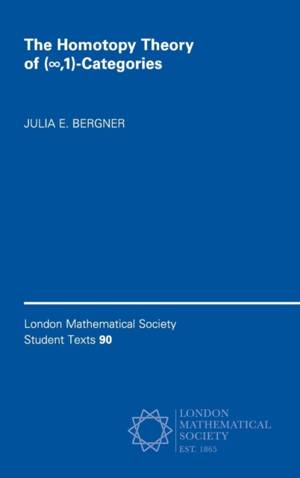
Door een staking bij bpost kan je online bestelling op dit moment iets langer onderweg zijn dan voorzien. Dringend iets nodig? Onze winkels ontvangen jou met open armen!
- Afhalen na 1 uur in een winkel met voorraad
- Gratis thuislevering in België vanaf € 30
- Ruim aanbod met 7 miljoen producten
Door een staking bij bpost kan je online bestelling op dit moment iets langer onderweg zijn dan voorzien. Dringend iets nodig? Onze winkels ontvangen jou met open armen!
- Afhalen na 1 uur in een winkel met voorraad
- Gratis thuislevering in België vanaf € 30
- Ruim aanbod met 7 miljoen producten
Zoeken
Omschrijving
The notion of an (∞,1)-category has become widely used in homotopy theory, category theory, and in a number of applications. There are many different approaches to this structure, all of them equivalent, and each with its corresponding homotopy theory. This book provides a relatively self-contained source of the definitions of the different models, the model structure (homotopy theory) of each, and the equivalences between the models. While most of the current literature focusses on how to extend category theory in this context, and centers in particular on the quasi-category model, this book offers a balanced treatment of the appropriate model structures for simplicial categories, Segal categories, complete Segal spaces, quasi-categories, and relative categories, all from a homotopy-theoretic perspective. Introductory chapters provide background in both homotopy and category theory and contain many references to the literature, thus making the book accessible to graduates and to researchers in related areas.
Specificaties
Betrokkenen
- Auteur(s):
- Uitgeverij:
Inhoud
- Aantal bladzijden:
- 284
- Taal:
- Engels
- Reeks:
- Reeksnummer:
- nr. 90
Eigenschappen
- Productcode (EAN):
- 9781107101364
- Verschijningsdatum:
- 27/04/2018
- Uitvoering:
- Hardcover
- Formaat:
- Genaaid
- Afmetingen:
- 162 mm x 236 mm
- Gewicht:
- 521 g

Alleen bij Standaard Boekhandel
+ 403 punten op je klantenkaart van Standaard Boekhandel
Beoordelingen
We publiceren alleen reviews die voldoen aan de voorwaarden voor reviews. Bekijk onze voorwaarden voor reviews.











